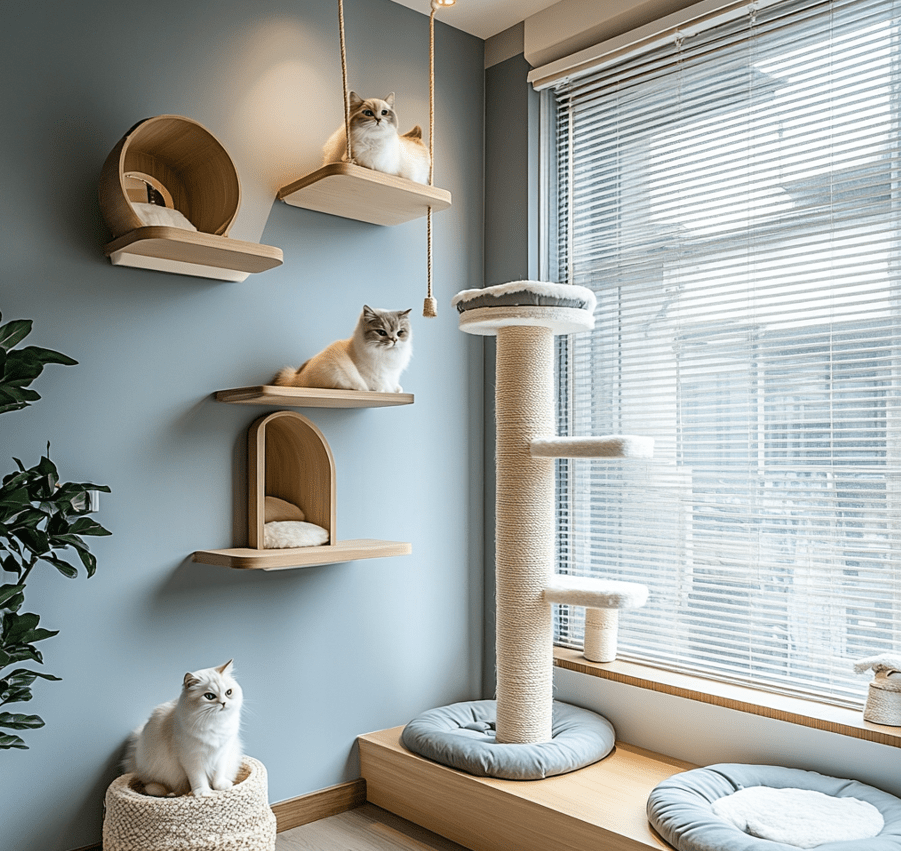
British Shorthairs, with their plush coats and gentle demeanor, are cherished companions, but like any breed, they can develop sensitivities to certain foods. Recognizing British Shorthair food allergies is crucial for ensuring your cat’s comfort and long-term health. Food allergies in British Shorthairs can manifest as skin issues, digestive problems, or behavioral changes, often going unnoticed until symptoms worsen. This comprehensive guide explores how to identify food allergies in British Shorthairs, their common triggers, diagnostic methods, and effective management strategies. By understanding and addressing food allergies, you can help your British Shorthair thrive with a healthy, happy life.
Understanding British Shorthair Food Allergies
Food allergies occur when a British Shorthair’s immune system mistakenly identifies a specific food ingredient as harmful, triggering an inflammatory response. Unlike food intolerances, which primarily cause digestive upset, British Shorthair food allergies involve an immune reaction that often affects the skin, gastrointestinal tract, or both. These allergies can develop at any age, even in cats that have eaten the same food for years without issues. Early detection is key to preventing discomfort and complications, such as chronic skin infections or weight loss.
Food Allergies vs. Food Intolerances
To effectively spot British Shorthair food allergies, it’s important to distinguish them from food intolerances:
Food Allergies: Immune-mediated reactions causing symptoms like itching, skin rashes, or chronic ear infections. Common triggers include proteins like beef, chicken, or fish.
Food Intolerances: Non-immune reactions, typically causing digestive issues like vomiting or diarrhea. Lactose intolerance (e.g., from milk) is a common example.
Understanding this distinction helps you identify whether your British Shorthair’s symptoms require a dietary overhaul or a simpler adjustment.
Common Symptoms of British Shorthair Food Allergies
Spotting British Shorthair food allergies involves recognizing a range of symptoms, which can vary in severity. The most common signs include:

1. Skin and Coat Issues
Itching and Scratching: Persistent scratching, especially around the head, neck, or ears, is a hallmark of food allergies.
Red or Inflamed Skin: Look for redness, particularly on the face, paws, or belly.
Hair Loss: Excessive grooming or scratching can lead to bald patches.
Skin Lesions or Sores: Small sores or scabs may develop from scratching.
Dull or Greasy Coat: Allergies can affect coat quality, making it less shiny or oily.
2. Gastrointestinal Symptoms
Vomiting: Frequent or occasional vomiting, especially after meals.
Diarrhea: Loose, watery, or frequent stools that persist.
Flatulence: Excessive gas or bloating, indicating digestive distress.
Loss of Appetite: Reluctance to eat, often due to discomfort.
3. Ear Infections
Recurrent Ear Issues: Chronic ear infections with redness, odor, or discharge are common in food-allergic cats.
Head Shaking: Frequent head shaking or ear scratching signals irritation.
4. Behavioral Changes
Lethargy: Reduced energy or playfulness due to discomfort.
Irritability: Increased aggression or withdrawal from interaction.
Over-Grooming: Excessive licking or chewing, especially on the legs or belly, leading to skin damage.
5. Respiratory Symptoms (Rare)
Sneezing or Wheezing: Though less common, some cats may show mild respiratory signs with food allergies.
If your British Shorthair exhibits any of these symptoms, particularly skin or digestive issues that persist, food allergies could be the culprit. Keep a detailed record of symptoms, including when they occur and their severity, to aid diagnosis.
Common Triggers of British Shorthair Food Allergies
The most frequent culprits behind British Shorthair food allergies are proteins, though other ingredients can also trigger reactions. Common allergens include:
Beef: A leading cause of food allergies in cats.
Chicken: Common in cat foods, making it a frequent allergen.
Fish: Salmon, tuna, or whitefish can trigger reactions.
Dairy: Milk or cheese often causes allergies or intolerances due to lactose.
Eggs: Less common but can cause skin or digestive issues.
Grains: Wheat, corn, or soy may trigger allergies in sensitive cats.
Artificial Additives: Preservatives or colorings in low-quality foods can contribute.
British Shorthairs may also develop allergies to multiple ingredients, complicating diagnosis. Unlike environmental allergies (e.g., pollen), food allergies don’t typically cause seasonal symptoms, so persistent issues year-round are a red flag.
How to Spot and Diagnose British Shorthair Food Allergies
Diagnosing British Shorthair food allergies requires a systematic approach, as symptoms can mimic other conditions like flea allergies, environmental allergies, or infections. Follow these steps to identify food allergies:
1. Observe and Document Symptoms
Track your cat’s symptoms, noting:
Timing: Do symptoms worsen after meals or with specific foods?
Duration: Are symptoms chronic (lasting weeks) or intermittent?
Location: Are skin issues focused on the head, ears, or elsewhere?
Diet History: What foods has your cat eaten recently, including treats or human foods?
Share this information with your veterinarian to narrow down potential causes.
2. Visit Your Veterinarian
A vet will perform a physical exam and may conduct tests to rule out other conditions:
Skin Scrapings: To check for parasites like mites.
Fungal or Bacterial Cultures: To identify infections.
Blood Tests: To assess overall health or screen for systemic issues.
Flea Checks: To confirm flea allergies aren’t the cause.
If food allergies are suspected, your vet will likely recommend an elimination diet, the gold standard for diagnosis.
3. Conduct an Elimination Diet
An elimination diet involves feeding your British Shorthair a novel or hydrolyzed protein diet for 8–12 weeks to identify allergens. Steps include:
Choose a Novel Protein: Select a protein your cat hasn’t eaten before, such as rabbit, venison, or duck (e.g., Royal Canin Selected Protein PR).
Hydrolyzed Option: Alternatively, use a hydrolyzed protein diet (e.g., Hill’s Prescription Diet z/d), where proteins are broken down to avoid immune reactions.
Strict Adherence: Feed only the prescribed diet, avoiding treats, table scraps, or flavored medications.
Monitor Symptoms: Improvement in symptoms (e.g., less itching or better stools) suggests a food allergy.
Rechallenge: Reintroduce the original food to confirm the allergy; if symptoms return, the allergen is identified.
Elimination diets require patience and discipline, as even small deviations can skew results.
4. Work with a Veterinary Dermatologist (If Needed)
If symptoms persist or are severe, a veterinary dermatologist can perform advanced diagnostics, such as intradermal skin testing or blood allergy panels, though these are less reliable for food allergies than elimination diets.
Managing British Shorthair Food Allergies
Once British Shorthair food allergies are confirmed, management focuses on avoiding allergens and supporting your cat’s health. Here’s how to manage food allergies effectively:

1. Feed a Hypoallergenic Diet
Switch to a permanent diet that avoids the identified allergen. Options include:
Novel Protein Diets: Use proteins like rabbit, kangaroo, or quail (e.g., Blue Buffalo Natural Veterinary Diet NP).
Hydrolyzed Protein Diets: Continue with hydrolyzed formulas for cats with multiple allergies.
Limited Ingredient Diets (LID): Choose foods with minimal ingredients to reduce the risk of reactions (e.g., Instinct Limited Ingredient Diet).
Ensure the diet is complete and balanced, meeting your British Shorthair’s needs for protein, taurine, and other nutrients.
2. Avoid Allergen Exposure
Eliminate all sources of the allergen, including:
Treats: Use hypoallergenic treats or pieces of the prescribed diet.
Human Foods: Avoid table scraps, especially common allergens like dairy or fish.
Flavored Medications: Request unflavored or hypoallergenic options from your vet.
Check ingredient labels carefully, as allergens can hide in unexpected places (e.g., “natural flavors” in treats).
3. Support Skin and Coat Health
Food allergies often cause skin issues, so incorporate supportive care:
Omega-3 Fatty Acids: Fish oil or krill oil reduces inflammation and promotes a healthy coat (e.g., Nordic Naturals Omega-3 Pet).
Grooming: Brush weekly to remove allergens and distribute natural oils, preventing matting.
Bathing: Use a vet-recommended hypoallergenic shampoo to soothe irritated skin.
4. Manage Secondary Infections
Food allergies can lead to skin or ear infections. Your vet may prescribe:
Antibiotics: For bacterial infections.
Antifungals: For yeast infections.
Anti-Itch Medications: Steroids or antihistamines to reduce scratching.
Follow treatment plans to prevent recurrence while addressing the root allergy.
5. Monitor for Recurrence
Regularly check for returning symptoms, as new allergies can develop. Weigh your cat monthly to ensure they maintain a healthy weight, as dietary changes can affect appetite or metabolism.
6. Consult Your Vet Regularly
Schedule follow-up visits to assess your British Shorthair’s progress and adjust the diet or treatments as needed. Annual exams can catch related issues, such as obesity or urinary problems, common in this breed.
Preventing British Shorthair Food Allergies
While not all food allergies can be prevented, these steps reduce the risk and support overall health:
1. Feed High-Quality Food
Choose cat foods with real meat as the first ingredient and minimal fillers (e.g., corn, soy). High-quality diets reduce the likelihood of sensitivities.
2. Introduce Foods Gradually
When switching foods or introducing treats, transition over 7–10 days to monitor for reactions:
Days 1–3: 25% new food, 75% old.
Days 4–6: 50% new, 50% old.
Days 7–9: 75% new, 25% old.
Day 10: 100% new food.
3. Limit Table Scraps
Avoid human foods, especially common allergens like dairy, fish, or beef, which can trigger sensitivities over time.
4. Maintain a Healthy Weight
Obesity exacerbates skin issues and inflammation. Use a British Shorthair feeding schedule with controlled portions to prevent weight gain.
5. Support Gut Health
Probiotics or prebiotics in food (e.g., Purina Pro Plan Veterinary Diets FortiFlora) can strengthen the gut microbiome, potentially reducing allergy risks.
Common Mistakes to Avoid
When addressing British Shorthair food allergies, steer clear of these pitfalls:
Ignoring Symptoms: Mild itching or occasional vomiting may seem minor but can indicate allergies.
Incomplete Elimination Diets: Giving treats or scraps during the trial invalidates results.
Assuming All Symptoms Are Allergies: Fleas, infections, or environmental allergens can mimic food allergies.
Using Low-Quality Foods: Cheap foods with fillers increase allergy risks.
Delaying Veterinary Care: Chronic symptoms can lead to infections or permanent skin damage.
Conclusion

Spotting British Shorthair food allergies is a vital step in ensuring your cat’s comfort and well-being. By recognizing symptoms like itching, vomiting, or ear infections, identifying triggers through elimination diets, and managing allergies with hypoallergenic diets and supportive care, you can help your British Shorthair lead a healthy, symptom-free life. The detailed steps, preventive tips, and expert advice in this guide empower you to address food allergies with confidence. Pair these strategies with regular veterinary care, proper nutrition, and attentive monitoring to keep your British Shorthair’s skin, coat, and overall health in top condition.




